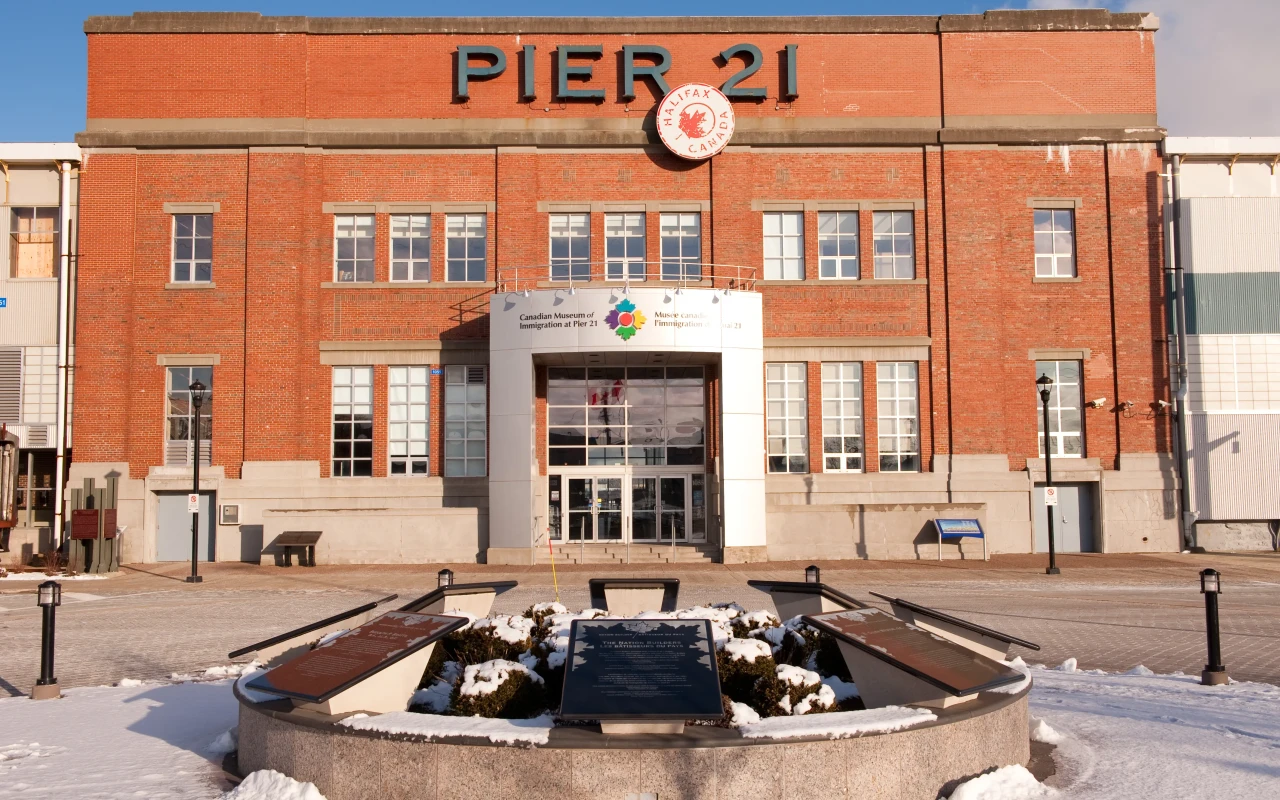Claim to Fame
Pier 21 is Canada’s national immigration museum, located in the historic ocean liner terminal that welcomed over one million immigrants between 1928 and 1971.
📌 Navigating Canadian Museum of Immigration at Pier 21 : Answers to Frequently Asked Questions
- Washrooms: Accessible restrooms and baby-changing facilities are available.
- Hours of Operation: The museum is open daily, with hours varying by season.
- Important Information: Check for special exhibitions, workshops, and educational programs offered throughout the year.
- Admission Fee: An admission fee is required for entry.
- How Long to Visit: Visitors typically spend 2-3 hours exploring the exhibits.
- Parking: Parking is available at the museum.
- Family Friendly: The museum is family-friendly with interactive exhibits and activities for children.
- Photography: Photography is allowed for personal use; some restrictions may apply to temporary exhibits.
- WIFI: Free WIFI is available for visitors throughout the museum.
- Picnic Area: Family friendly for all ages. Diaper changing tables available in all public washrooms.
- Handicap Accessible: The museum is fully accessible for visitors with disabilities.
- Pets: Service animals are welcome; pets are not permitted.
- Guided Tours: Guided tours are available, providing comprehensive insights into Canada's immigration history.
- Restaurant or Cafe: A cafe is available on-site, and there are picnic areas nearby along the waterfront.
- Gift Shop: The gift shop offers a range of books, gifts, and souvenirs related to immigration and Canadian history.
Photos of Canadian Museum of Immigration at Pier 21
Housed in the restored 1928 ocean liner terminal on Halifax’s bustling waterfront, the Canadian Museum of Immigration at Pier 21 tells the stories of those who passed through Canada’s “golden door.” Through personal artifacts, oral histories, and immersive galleries, visitors trace the journeys of war brides, displaced Europeans, veterans, and newcomers from around the globe. This living museum honors the resilience and diversity that have shaped modern Canada.
What to Expect
Begin in the Departure Hall, where luggage tags, steamer trunks, and ship’s schedules evoke the anticipation and anxiety of transatlantic voyages. Interactive passenger “family stories” allow you to hear firsthand accounts—through audio recordings and video interviews—of arrivals, first jobs, and settlement challenges.
In the Arrival Hall gallery, step off a replica gangway into a 1940s “welcome” scene complete with costumed interpreters. Explore thematic exhibits on refugee programs, postwar immigration waves, and Canada’s evolving multicultural identity. The Children’s Discovery Gallery invites families to pack virtual trunks, learn non-verbal communication games, and trace migration maps with a touch-screen world atlas.
Background and Cultural Context
From its opening in 1928, Pier 21 served as Halifax’s ocean liner terminal, processing more than 1.5 million immigrants, war brides, and soldiers returning home. As Canada’s busiest port of entry, it witnessed key chapters: the arrival of displaced persons after WWII, the arrival of Hong Kong migrants in 1967, and the final sailing in 1971 before the terminal closed.
Designated a National Historic Site in 1997, the building’s brick façade, grand halls, and original baggage scales were meticulously restored. Since opening as a museum in 2011, Pier 21 has partnered with immigrant communities, historians, and descendants to expand its archives and foster dialogue on welcoming newcomers.
Best Time to Visit
Weekday mornings (10–11:30 AM) offer quieter galleries and scheduled curator talks. Summer (June–August) brings extended hours and special events like “Stories in Stone” evening tours on the pier deck. Fall (September–November) features Refugee Week programs and storytelling festivals. Check for multilingual guided tours and First Voices presentations by Mi’kmaq Elders in June.
How to Get There
Located at 1055 Marginal Road, the museum is a 10-minute walk east from Halifax Ferry Terminal or bus routes 1 and 10 to Lower Water Street. Paid parking is available at the lot beside the museum; metered street parking and green P facilities are nearby on Marginal Road.
Photo Opportunities
- The museum’s brick Departure Hall framed by vintage baggage scales and a steamship mural
- Costumed interpreter in 1940s period dress on the Arrival Hall replica gangway
- Interactive family story kiosk with touchscreens and historic portraits
- Evening “Stories in Stone” glow of exterior lighting on the pier deck
- Children packing virtual trunks at the Discovery Gallery with Halifax Harbour views beyond
Travel Tips
- Purchase timed-entry tickets online to guarantee your preferred arrival slot.
- Allow 1.5–2 hours for a full visit, including the Trace Your Roots research station.
- Take advantage of free “Ancestry Day” sessions held quarterly for personal genealogy research.
- Combine your museum visit with a stroll along the waterfront boardwalk to the nearby Maritime Museum of the Atlantic.
- Family passes and senior discounts offer savings on admission and guided tours.
FAQs
Is there an admission fee?
Yes—Adults CAD 16; Seniors/Students CAD 14; Youth (6–17) CAD 12; Children under 6 free; family and group rates available.
Are guided tours available?
Yes—daily guided tours depart at 11 AM and 2 PM; multilingual audio guides are included with admission.
Is the museum accessible?
The facility is fully wheelchair accessible, with elevators to all levels and accessible washrooms. Hearing-assist devices are available.
Can I research my own family history?
Yes—the Trace Your Roots research station offers free access to immigration records, census data, and expert assistance by appointment.
Final Thoughts
The Canadian Museum of Immigration at Pier 21 stands as both a tribute and a promise—honoring the courage of past generations and inspiring visitors to embrace Canada’s ongoing story of welcome and belonging. Through its authentic spaces and personal narratives, Pier 21 delivers an immersive journey into the heart of Canada’s immigrant heritage.
